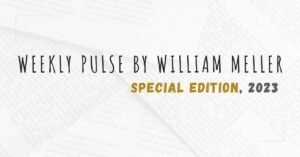The Weekly Pulse is my content curation and my highlights from readings, books, podcasts, insights, and everything I discovered during the week.
So, let’s go with some discoveries from the week!
#1 – Primal Leadership: The Hidden Driver of Great Performance
#2 – How Companies Can Help Midlevel Managers Navigate Agile Transformations
#3 – Persuade Your Company to Change Before It’s Too Late
#4 – How to Think Clearly
#5 – Beyond Theory Y
Primal Leadership: The Hidden Driver of Great Performance
Source: Harvard Business Review
Author: Daniel Goleman, Richard Boyatzis, and Annie McKee
Summary: We’ve known for years that emotional intelligence improves results—often by an order of magnitude. Now, new research shows that a leader’s mood plays a key role in that dynamic—a discovery that should redefine what leaders do first and best.
3 Highlights:
“… When we say that managing your mood and the moods of your followers is the task of primal leadership, we certainly don’t mean to suggest that mood is all that matters…“
“… Emotional leadership is the spark that ignites a company’s performance, creating a bonfire of success or a landscape of ashes. Moods matter that much…“
“… As we’ve noted, your actions are critical, and mood and actions together must resonate with the organization and with reality. Similarly, we acknowledge all the other challenges leaders must conquer—from strategy to hiring to new product development. It’s all in a long day’s work…”
Access the Weekly Pulse here >>
How Companies Can Help Midlevel Managers Navigate Agile Transformations
Source: McKinsey
Author: Aaron De Smet, Chris Smith, and Daidree Tofano
Summary: In this article, McKinsey explores how conventional organizations can turn midlevel managers into champions of enterprise agility by explaining what the transformation involves, explicitly communicating their expectations and the options available to managers, and enabling managers as they choose new roles and learn to work in agile settings.
3 Highlights:
“… Since many midlevel managers possess a wealth of experience, knowledge, and skill, redeploying them as hands-on individual contributors is one way to let them accomplish more than they do in managerial roles…“
“… Another way is to give midlevel managers the support and training they need to become leaders, with more responsibility for inspiring teams and providing them with the assistance and resources they need to be effective…“
“… Helping mid-level managers make the transition to agile can take a lot of effort, but the payoff is worthwhile. Companies have long sought ways of enabling midlevel managers to add more value...”
Access the Weekly Pulse here >>
Persuade Your Company to Change Before It’s Too Late
Source: Harvard Business School
Author: Pontus M.A. Siren, Scott D. Anthony, and Utsav Bhatt
Summary: How can leaders build the conviction to act before evidence is abundantly clear? First, they can gather “private data” (from their employees, customers, and proprietary systems) that illuminates the risks firms face. Second, they can map their firms’ position on the information-action paradox model and use it and other disruption frameworks to inform discussions that lower the threshold of proof
3 Highlights:
“… But by the time data about disruptive trends is public, opportunities have shrunk or disappeared, and their firms may be on burning platforms…”
“… On the other hand, by the time public data about disruptive trends and market shifts is convincing, the window of opportunity has shrunk, if not disappeared…”
“… The lesson: Avoid ever ending up on a burning platform. But that requires leaders to act before compelling data is widely available...”
Access the Weekly Pulse here >>
How to Think Clearly
Source: Psyche
Author: Tom Chatfield
Summary: By learning to question and clarify your thoughts, you’ll improve your self-knowledge and become a better communicator. Clarifying your thinking is a process: one that’s necessarily incremental, iterative, and imperfect. There’s no such thing as a perfectly clear statement. What’s on your mind?
3 Highlights:
“… Firstly: pause. It’s only by slowing down and attending carefully to your own thoughts that you can hope to embark upon a process of clarification…”
“… Be explicit about the relevant assumptions your reasoning relies on. These will invariably include some claims you believe to be fundamental. Be aware that two perfectly reasonable lines of argument based upon different fundamental assumptions could lead to very different conclusions…”
“… Don’t be seduced by oversimplifications or too tidy a formulation of complex issues. It’s important to be as clear as possible about the tensions, ambivalence, and ambiguities you’re grappling with. Addressing complex ideas lucidly isn’t the same as pretending they’re simple…”
Access the Weekly Pulse here >>
Beyond Theory Y
Source: Harvard Business Review
Author: John J. Morse and Jay W. Lorsch
Summary: During the past 30 years, managers have been bombarded with two competing approaches to the problems of human administration and organization. The first, usually called the classical school of organization, emphasizes the need for well-established lines of authority, clearly defined jobs, and authority equal to responsibility. The second, often called the participative approach, focuses on the desirability of involving organization members in decision-making so that they will be more highly motivated.
3 Highlights:
“… Theory X assumes that people dislike work and must be coerced, controlled, and directed toward organizational goals. Furthermore, most people prefer to be treated this way, so they can avoid responsibility…”
“… Theory Y emphasizes the average person’s intrinsic interest in his work, his desire to be self-directing and to seek responsibility, and his capacity to be creative in solving business problems…”
“… The basic deficiency with earlier approaches is that they did not recognize the variability in tasks and people which produces this complexity. The strength of the contingency approach we have outlined is that it begins to provide a way of thinking about this complexity, rather than ignoring it…”
Access the Weekly Pulse here >>
Do you want to get new content in your Email?
I am incredibly grateful that you have taken the time to read this Weekly Pulse.
The Weekly Pulse is an important section of this website, aiming to share good stuff with you every week!
Do you want to explore more? Check more Weekly Pulse content here.
Check my main categories of content below:
- Agile
- Blog
- Book Notes
- Career
- Leadership
- Management
- Managing Yourself
- Productivity
- Project Management
- Technology
- Weekly Pulse
Navigate between the many topics covered in this website:
Agile Art Artificial Intelligence Blockchain Books Business Business Tales Career Coaching Communication Creativity Culture Cybersecurity Design DevOps Economy Emotional Intelligence Feedback Flow Focus Gaming Goals GPT Habits Health History Innovation Kanban Leadership Lean Life Managament Management Mentorship Metaverse Metrics Mindset Minimalism Motivation Negotiation Networking Neuroscience NFT Ownership Parenting Planning PMBOK PMI Politics Productivity Products Project Management Projects Pulse Readings Routines Scrum Self-Improvement Self-Management Sleep Startups Strategy Team Building Technology Time Management Volunteering Work
Do you want to check previous Weekly Pulse posts? Check the last couple of weeks:
- Weekly Pulse by William Meller | Special Edition, 2023
- Weekly Pulse by William Meller | Week 51, 2023
- Weekly Pulse by William Meller | Week 50, 2023
- Weekly Pulse by William Meller | Week 49, 2023
- Weekly Pulse by William Meller | Week 48, 2023
Support my work by sharing my content with your network using the sharing buttons below.
Want to show your support tangibly? A virtual coffee is a small but nice way to show your appreciation and give me the extra energy to keep crafting valuable content! Pay me a coffee:





